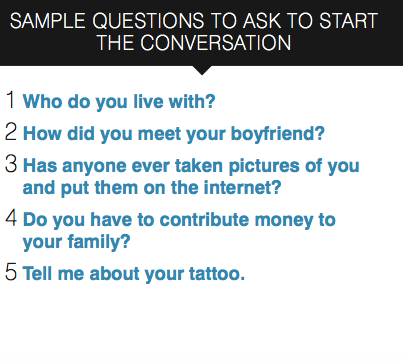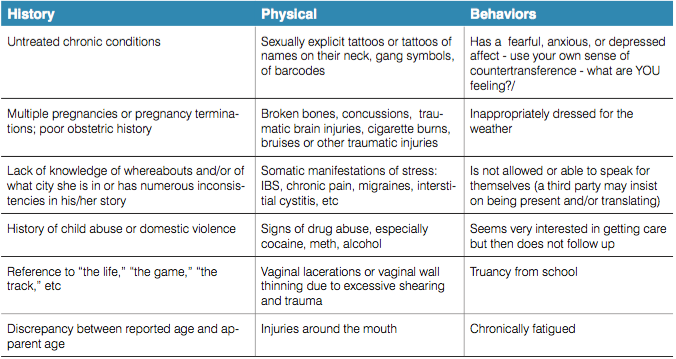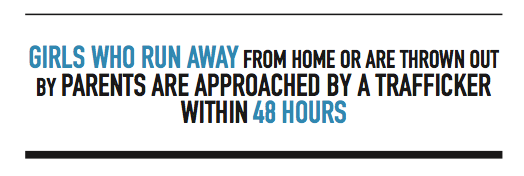The devil is in the detail: Practical aspects of identifying and responding to sex trafficking
Human trafficking, or rather, modern slavery, is an insidious and pervasive problem in our society.

Julia Geynisman, MD

Debra Taubel, MD
While at the scrub sink several weeks ago, an attending obstetrician told me the story of a tattoo he had seen on a patient several years ago: “We were placing the Foley when we saw this life-size tattoo of a ruler on her inner thigh. You know, the full 12-inch school ruler kind. We asked her what the story was and the patient gave us attitude about the tattoo - didn’t want to really explain what it meant - she was a real tough girl, you know, and then she said, ‘its to measure the man’s penis.’” The obstetrician enjoyed this story and told it as a humorous example of how far modern women have come in their sexual empowerment. It was clear that he was oblivious of the possibility that this tattoo was not drawn by choice. Unfortunately, tattoos such as this are one of the hallmarks of the commercial sex industry - an exam finding that most of us in medicine are blind to recognizing and paralyzed to act on.
Recommended: Counseling women on reproductive and sexual coercion
Human trafficking, or rather, modern slavery, is an insidious and pervasive problem in our society. The United Nations defines sex trafficking as the recruitment, transportation, transfer, or harboring or an individual by means of threat, force, coercion or deception in order to exert control over that individual for the purpose of sexual exploitation. In the case of minors, no threat or coercion needs to occur. The legal definition simply states that any minor being sold for sex is a victim of trafficking.1
Sex trafficking makes up approximately 22% of all human trafficking and internationally, there are estimates that 4.5 million persons are trapped in sexual exploitation.2 Although many physicians think that sex trafficking is a global health problem occurring in third world economies, 77% of the cases of sex trafficking in the US are of domestic women, according to the National Human Trafficking Resource Center. Sex trafficking generates profits of up to US $34 billion annually, with half of those profits being made in industrialized countries.3 It is currently surpassing the illegal arms trade as the second largest criminal enterprise in the world. Sadly, traffickers have learned that women can be sold many more times than a gun and that while guns can only serve as evidence, victims of trafficking can be criminalized as prostitutes.
NEXT: What are the signs?
For us in healthcare, these statistics mean that many of us will encounter more than one survivor of trafficking in our careers. It is estimated that although 30% of trafficked individuals will be exposed to the healthcare system for treatment of an illness or injury at some point during their captivity, they are seldom recognized as victims of human trafficking.4 That is because most healthcare workers do not recognize the signs. In one study of 168 healthcare workers who were provided with vignettes of patient encounters, 48% correctly classified a minor as a sex trafficking victim. 63% of respondents said that they had never received training on how to identify sex trafficking victims but those with training were more likely to report sex trafficking as a major problem locally, to have encountered a victim in their practice, and to have greater confidence in their ability to identify victims.5

More: Evaluating chronic sexual pain
We can do better. The red flags of sexual exploitation are both physical and psychological. Bruises or gray marks on the neck or inner thigh are especially concerning because these are naturally protected areas of our bodies. Tattoos of names (again on the neck, mons or thigh) or sexually explicit words or images should always prompt a question: “Who is John?”, “When did you get this tattoo?” or “What does this tattoo mean?” Other physical red flags include whether the patient’s clothing is appropriate for the season or whether her possessions match her circumstances (multiple expensive accessories or alternatively, carrying too many belongings in order to change between jobs). More often, survivors of trafficking may display psychological “red flags:” signs that they are being controlled by the person accompanying them, that they don’t know where they are or how to get themselves home, that they don’t have any money or don’t make decisions about their finances. This information is not easy to elicit in most health encounters but may become easier and less awkward if we practice taking a social history that includes more than just “smoking, alcohol and drugs.” Making a habit of asking simple questions like, “who lives with you at home,” and “what do you do for work” in all of our health encounters may allow room for disclosure. Often, there may not be a concrete sign at all - just the counter-transference of a feeling from the patient to you - a feeling that your exam is more stressful than it should be; a feeling of defeat and sadness throughout your conversation. Noticing your own body language and emotions can help you recognize and respond to the signs of trauma.
NEXT: What signs should you be looking for?
When performing the physical exam, there are a number of health consequences of sexual exploitation to be aware of. Victims suffer physical abuse in all of its forms and may have broken bones, concussions and burns. They may contract sexually transmitted infections, particularly because more money can be made for unprotected sex. They may suffer vaginal or anal lacerations, carry unwanted or ectopic pregnancies or have incorrectly managed abortions. Some are malnourished, not always calorically but nutritionally. Almost all have ongoing psychological health consequences. Neuropsychiatric conditions such as fatigue, dizziness, headaches and memory loss are almost ubiquitous. Perhaps the most overlooked health consequence is the delay in diagnosis and mismanagement of routine health conditions (hypertension, diabetes, autoimmune disorders, etc) because these women cannot physically or financially access healthcare. When working with a patient who seems to have let a condition go unaddressed for too long, it may be prudent to ask what prevented her from coming to medical attention sooner. For any survivor of trauma, sensitive exams like the pelvic exam should ideally be done only once and special attention paid to the choice of language and the position of the examiner. If possible, stand to the woman’s side instead of directly between the legs to insert the speculum or allow her to insert it herself. Phrases like “spread your knees” or “relax your butt” which are heard too often should be avoided with any patient, but particularly a survivor of trauma.

When these women do present for health care, the experiences they have are traumatic. Since they often present to emergent care settings, they are re-traumatized by being undressed and examined by multiple care providers in one visit. Those brave enough to report their situation often feel stigmatized by healthcare workers who hold on to myths about “choice” in the sex industry. And if they are not recognized as victims of trafficking, our system of outpatient referral and followup fails these patients.
In response to the criticism from survivors about their healthcare experiences, in 2013 we founded the Survivor Clinic at Weill Cornell - New York Presbyterian Hospital. This clinic provides free gynecologic and primary care to survivors of sex trafficking. The interview and exam methods are trauma-informed and the patients are often seen without any “chief complaint” for visits to discuss overall health and wellness. Patients have one point-of-contact whom they can grow to trust and have continuity with and who ensures follow-up appointments are made. Clinics like the Survivor Clinic are operating all over the US (CARE in Boston, Hope Through Health in Texas, Saban Free Clinic in LA, etc) and together are elevating the response to sex trafficking and training medical colleagues in identifying this issue.
NEXT: Preventing future exploitation
In addition to recognizing and getting help for survivors, OBGYNs can play an important role in prevention. When seeing young adult women in our offices or emergency rooms, we must take opportunities to warn young women at risk about the commercial sex industry. Risk factors for commercial sexual exploitation include homelessness (both as a runaway and so-called “throwaway” child), history of juvenile detention, and homosexual or transgendered identity.2 For these patients who have struggled to find acceptance among family or society, pimps are able to capitalize on their starvation for attachment with psychological abuse and control. Traffickers are approaching children after school and in malls, at friends’ parties and online. According to stats from the DOJ, 13 percent of young Internet users have received unwanted sexual solicitations and in 27 percent of these incidents, solicitors asked these users for sexual photographs of themselves. 6 But while some young women are at particularly high risk, it is important to realize that trafficking has no racial or economic boundaries. Victims may come from privileged backgrounds and be well-educated. They are not always living in barricaded basements - the psychological attachment to the trafficker is so strong that many victims go home to their own apartments or their parents’ home each night.

If providers have any suspicion about a patient being a victim of trafficking, there are a number of immediate and long-term resources available for consultation. The National Human Trafficking Resource Center hot line (1-888-373-7888) is available to anyone (healthcare professionals and citizens alike) with a suspicion that human trafficking may be taking place. It is toll free, available 24 hours a day. If you don’t have time to wait on the phone, a text message to BeFree (233733) can also start a conversation. If the patient is a minor, all suspected cases of trafficking should be reported to Child Protective Services. For adults, reporting is not mandatory and should be discussed with the patient, who may not be ready to leave or may feel this is dangerous to her. The social workers in your health care setting can help with this. It is important to remember when asking for help, that re-telling the story of trauma can be as upsetting as experiencing it, so it is often best to limit the number of repetitive interviews.
Next: Moving beyond screening for sexual coercion
As OBGYN’s, we are in a unique position to recognize, empower and treat the survivors. Too often, we fail to recognize the signs or have the courage to ask the difficult questions. After her delivery, the patient with the ruler tattoo never presented for follow-up. It is certainly possible that her tattoo was for nothing more than her own pleasure but we will never know. If, in fact, she was a victim of trafficking, given that the average length of time a woman is trafficked is 18 months, I can only hope that she is out of the life and is healing.
References:
1. Trafficking in Persons Report 2012 http://www.unodc.org/documents/data-and-analysis/glotip/Trafficking_in_Persons_2012_web.pdf
2. Polaris Project. Available at: http://www.polarisproject.org/. Accessed December 1, 2015.
3. Belser et al. Estimating the Profits of Human Trafficking. 2005. International Labour Office in Geneva, Switzerland.
4. FVPF (Family Violence Prevention Fund). 2005. Trafficking survivors’ perspectives on early intervention strategies. San Francisco, CA: FVPF.
5. Beck ME, Lineer MM, Melzer-lange M, Simpson P, Nugent M, Rabbitt A. Medical providers' understanding of sex trafficking and their experience with at-risk patients. Pediatrics. 2015;135(4):e895-902.
6. Department of Justice. Available at: http://www.justice.gov/psc. Accessed December 1, 2015.
Setting up a clinic
If anyone wants to learn more about the process, they can email the Survivor Clinic at survivorclinicnyc@gmail.com or they can contact the HEAL Trafficking network which is a network of health providers across the United States who are working with these patients.
Introducing the topic of sexual solicitation to young patients
Unfortunately, adolescence is too late to start talking to children about sexual solicitation. By the age of 11, most children have seen porn and some as early as age 6. 1 in 7 children are approached online through social networks and chat rooms for sexual solicitation or photographs. By adolescence, children are using the word “pimp” to describe the things they are most proud of or excited about. By adolescence, children are playing Grand Theft Auto 5, in which they get to choose a prostitute to pick up, choose from a menu of sexual acts and then choose the weapon with which to kill her. By adolescence, girls have one or more social networking sites through which pimps learn their interests and their whereabouts. Start the conversation with your adolescent patients by asking, “Have any of your friends ever talked about getting paid to go on dates?” “Do you know what sexting is?” “Has anyone ever sent you a picture that made you feel uncomfortable?” “What would you do if someone sent you an inappropriate picture or asked you for one? “What would you do if a good looking older guy came up to you at the mall and said he thought you were pretty enough to be a model?”
